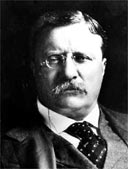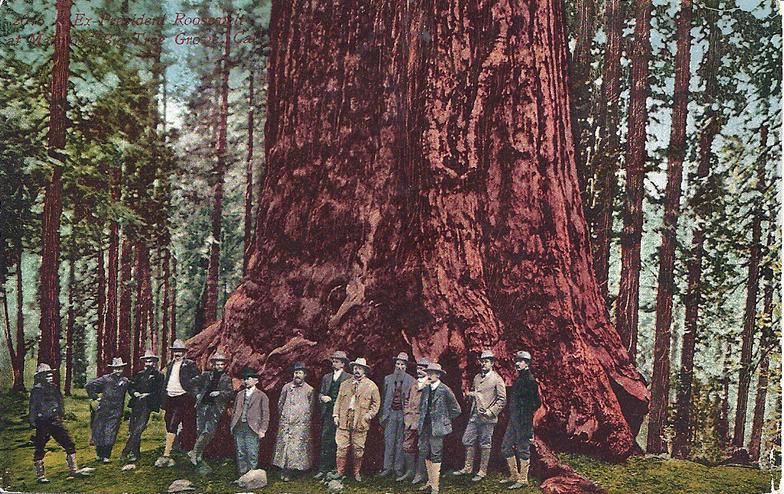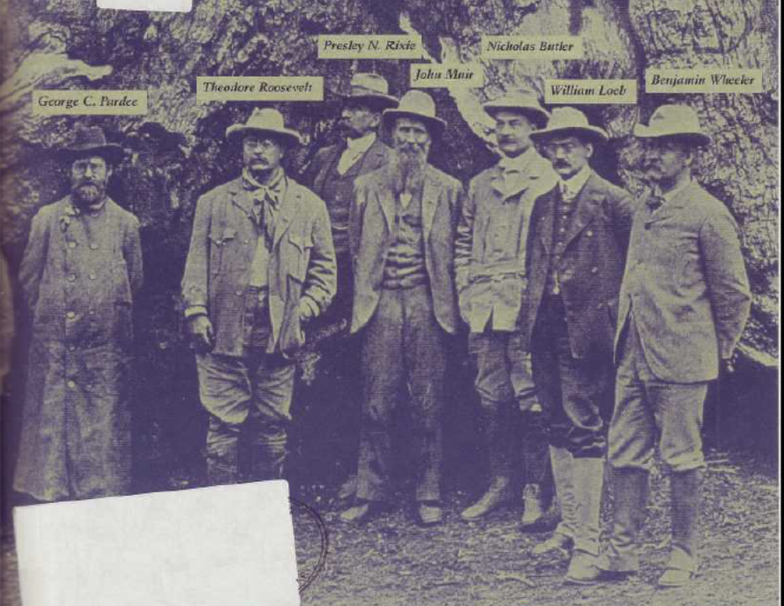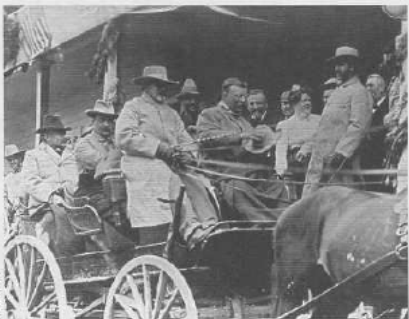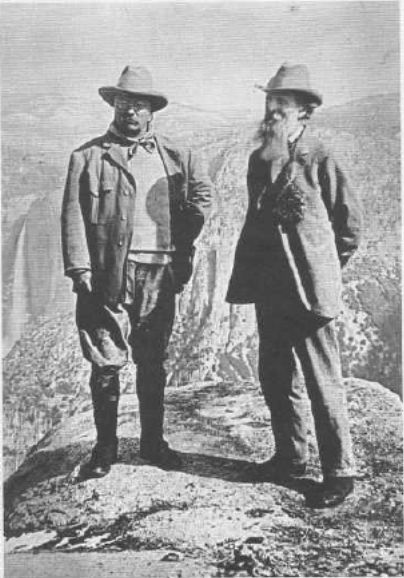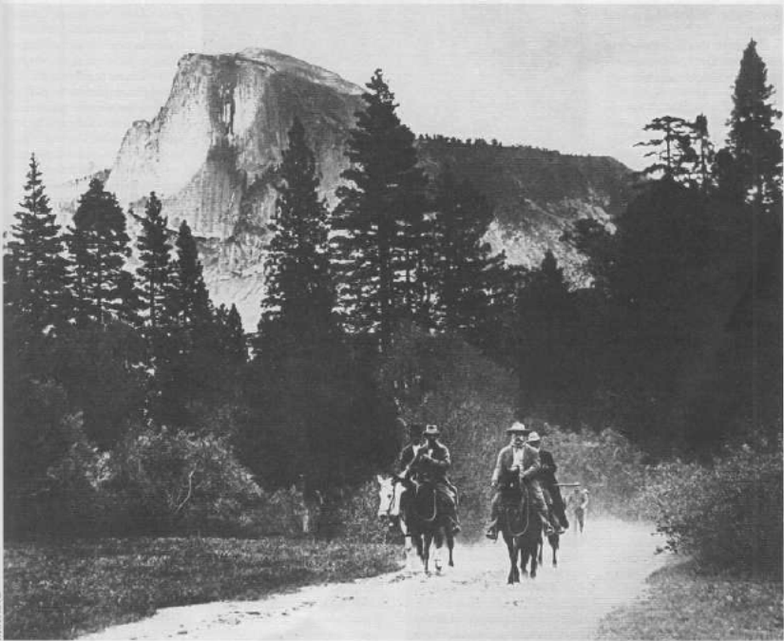We're committed to helping you
President Teddy Roosevelt Visits Yosemite - May 15 - 18 1903
Teddy Roosevelt was a man of action born to great wealth. President McKinley left the convention open in 1901, allowing Roosevelt to be nominated for vice president. In so doing he knew Roosevelt would be a spokesman for American Imperialism because of his whole-hearted support of this policy during the Spanish American War in 1898. Roosevelt
helped form the famous Rough Riders, a combination of wealthy Easterners
and Western cowboys. Having gained national fame for his courage in battle
in Cuba, he returned to be elected Governor of New York. As the
GOP nominee for Vice President with William McKinley, campaigning
successfully against radicalism and for prosperity, national honor,
imperialism (regarding the Philippines), high tariffs and the gold
standard.
Roosevelt would become a Progressive after reading "The Promise of American Life," by Herbert Croly while on safari in Africa after leaving office.
necessary arrangements followed, and at 7:30 on the morning of May 15, 1903, having traveled overnight from Oakland, the Presidential special train pulled into Raymond station, the nearest mainline rail connection to Yosemite, with Muir and Roosevelt on board. According to witnesses, a band was playing, bunting and flags waved from every building, and more than a thousand cheering spectators were assembled in eager anticipation of the President's arrival.
"Some what disconcerted by the unexpected attention, Roosevelt, dressed informally in Norfolk coat, baggy breeches, leather puttees (leggings), neckerchief, and nondescript sombrero, briefly addressed the crowd from the verandah of the Bowen Hotel before entering the first of two eleven-passenger stages that were waiting to transport him and his entourage to the Mariposa Grove of Big Trees. The President sat in the front seat of the lead vehicle beside veteran Yosemite Stage & Turnpike Company driver Bright Gillespie. Muir sat directly behind Roosevelt so he could point out places of interest. They were joined by the remaining members of the official party: Secretary of the Navy William H. Moody; California Governor George C. Pardee; Dr. Presley N. Rixie, Surgeon General; Nicholas Murray Butler, President of Columbia University ; Roosevelt's private secretary William Loeb, Jr.; and Benjamin Ide Wheeler. The second stage, which followed a short distance behind, carried four Secret Service agents and various other attendants. Accompanying the stages was a crack detachment of thirty U .S . cavalrymen, mounted on matching dapple-gray horses, commanded by a Lieutenant Mays.
From a book by Hank Johnston
PAGE TWO
YOSEMITE ASSOCIATION, SUMMER 1994
A Camping Trip with Roosevelt and Muir
Roosevelt's particular desires was to spend several days camping in Yosemite with the noted conservationist John Muir, whose writings on the subject of preserving unspoiled places had attracted national attention. Muir had already arranged a forest inspection trip to Asia with Professor Charles S. Sargent, Director of the Arnold Arboretum at Harvard University but Muir's close friend William E. Colby and Benjamin Ide Wheeler, President of the University of California, persuaded him to postpone his journey in order to fulfill the President's request.
"An influential man from Washington wants to make a trip into the Sierra with me, Muir apologetically wrote Sargent. "I might be to do some forest good in freely talking around the campfire" The
President Theodore Roosevelt
John Muir
Photo taken by Arthur C. Pillsbury, later colorized and used as a post card.
Photo from the article.
He also sent away the press and photographers, who fully expected Roosevelt to rejoin them later at the bedecked
Wawona Hotel where a lavish banquet was scheduled for 6:00 p.m. The President then bade a temporary goodbye to the members of his party who, except for Muir, reboarded the stage and headed for the sanctuary of the hotel six miles away.
This left Roosevelt, Muir, Park Rangers Charles Leidig and Archie Leonard, and an Army packer named Jackie Alder alone in the Grove. Camp was soon set up near a cool spring not far from the Sunset Tree . Leidig, the first white boy born in Yosemite Valley and an excellent camp cook, prepared fried chicken and beefsteak for dinner served on tin plates by the campfire . After drinking several cups of strong black coffee, the President bedded down early on forty thin Army blankets, which had been piled under a shelter — half to provide both mattress and covering . "He got just as deep into these as he wanted ' Leidig said.
At 6:30 the following morning, the group was already in the saddle, heading for Glacier Point. The San Francisco Chronicle described their journey: "Avoiding the main road, and long before most of his associates were out of bed
at Wawona, the President, filled with his usual enthusiasm for adventure, passed rapidly down the narrow defile known as the `Lightning Trail' and struck off for Yosemite Valley . An hour later the main road was reached, and the steep ascent to the top of Chilnualna Fall was begun . The party reached the summit before noon, and then the difficult portion of the trip began . Here the party not only had the steep ascents but the deep snow as well .' Floundering in drifts sometimes five feet deep, and further slowed by a blinding snowstorm that continued all afternoon, the weary travelers took turns breaking trail until they reached the meadow back of Glacier Point where they gladly pitched camp for the night .
Early the next morning (May 17), after shaking 5 inches of new snow from his blankets, Roosevelt shaved by the light of a great campfire, then joined Muir for a prearranged photographic session with a cameraman from the firm of Underwood and Underwood who was waiting to take the official pictures at Glacier Point.
After the customary lunch stop at the Ahwahnee Tavern, eighteen miles above Raymond, the party proceeded directly to the Mariposa Grove of Big Trees.
Here, following some preliminaries such as picture-taking at the Grizzly Giant and Wawona Tunnel Tree, the President dismissed the troops, thanking them for their services and calling out as they departed, "God bless you!"
About 2:30 that afternoon, a dust-covered Roosevelt and his equally begrimed companions road into Yosemite Village to find a large gathering of residents, tourists and the curious from as far away as Coulterville and Merced expectantly awaiting the distinguished visitors.
President Roosevelt and John Muir on Overhanging Rock
Unbeknown to the President, Guardian John Stevens and the Yosemite Commissioners had made elaborate arrangements to receive him A huge green "Welcome" sign hung across the Upper Iron Bridge ; $400 worth of fireworks were ready to be shot off; a sumptuous banquet catered by a chef imported from the Bohemian Club of San Francisco was in preparation at the Sentinel Hotel; and Stevens, some of the Commissioners, and the other members of the Presidential party were there to greet him . (In their Biennial Report for 1903-04, the Yosemite Commissioners listed an expense of $794.70 "for the entertainment of President Roosevelt.")
Annoyed at seeing the crowd, Roosevelt headed straight for artist Chris Jorgensen's studio across the Merced River, which had been provided for his use while in the Valley. Dismounting, he joined the collected dignitaries in a glass of cold champagne served by Jorgensen, after which Guardian Stevens presented him with the "key" to the Valley (made of manzanita by local wood- worker Julius Starke). When Governor Pardee began to talk of the the banquet, fireworks, and other festivities planned for that evening, the President's booming voice broke in : "We will pitch camp at Bridalveil!"
Muir had previously suggested that site for their last night in Yosemite. Roosevelt thanked the Jorgensens for their courtesy, remounted his horse, and headed back across the bridge. He paused long enough to briefly recall the stormy days of his famous charge up the hills near Santiago with a Mr. McPherson, a former member of the Seventh Infantry who had been closely associated with the Roughriders in Cuba. When the President saw Ellen Boysen, two-year-old daughter of Yosemite photographer Julius T . Boysen, standing alongside her mother holding a flag, he reached down and picked her up under her armpits . After kissing her, he said, "God bless you, you little angel;" and puther down.
As the five original riders turned west toward Bridalveil Meadow, a youngster called out, "Hi, Teddy" The President reined in his horse and gave the disrespectful lad a severe reprimand. (Laurence Degnan, a member of the pioneer Degnan family who was away at school at the time, said his mother always suspected his younger brother Chris, thirteen, of being the culprit — a charge Chris stoutly denied.)
Roosevelt then waved his companions on, and while the assemblage of disappointed spectators, including the chagrined Commissioners, stood watching, the Presidential party slowly disappeared in the distance, trailed by a long string of people on horseback, in surreys and buggies, and on foot. Camp was set up in a choice spot at the edge of Bridalveil Meadow just west of Bridalveil Fall (a marker identifies the approximate site today). Across the Merced River, El Capitan bulked impressively, and Ribbon Fall, the highest single drop in the Valley thundered down in full view. Privacy was finally achieved after Rangers Leidig and Leonard succeeded in chasing the congregating spectators away. "They went quietly “Leidig said, "some of them even on tiptoe, so as not to annoy their President."
Muir and Roosevelt talked long into the night around the campfire. "I stuffed him pretty well" Muir said later in a letter to Dr. C. Hart Merriam, "regarding the timber thieves, the destructive work of the lumberman, and other spoilers of the forest" That dialogue may have played a part in the President's subsequent pro-conservation actions. During the remainder of his term of office, Roosevelt assisted in adding 147 million acres to the country's forest reserves, created eighteen national monuments, and used his influence in the establishment of five national parks by Congress.
On the morning of May 18, Muir and the President joined the other members of the official party aboard the Cannonball stage to return to the waiting special train at Raymond. The trip was important in itself because driver Tom Gordon set a record for speed that was never equaled in the forty years of horse-drawn vehicles . In just ten hours of actual driving time, the party covered the sixty-seven miles from Yosemite Valley to Raymond . The total elapsed time was just short of twelve hours.
At Wawona, the president and his companions were treated to a champagne lunch by hosts Edward and John Washburn. Roosevelt toured Thomas Hill's studio (the artist gave him a painting of Bridalveil Fall he admired), signed the guest register, and said a few words to the assembled crowd before departing. When he arrived at Raymond, reporters asked him about the Yosemite adventure with Muir . The President told them he had thoroughly enjoyed it. "It was bully" he said. "I had the time of my life!”
Roosevelt Party entering Yosemite Valley
Setting out from the Wawona, Roosevelt in front seat.

